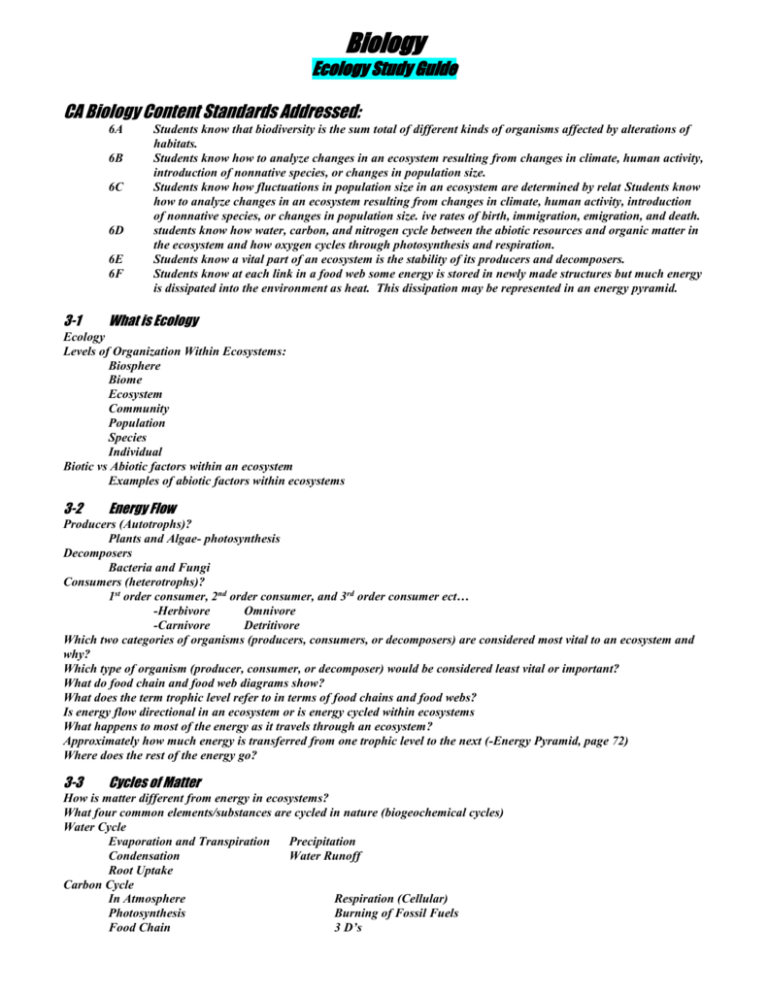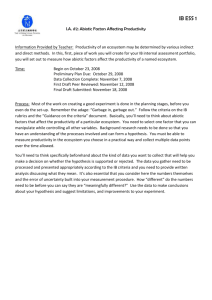Biology
advertisement

Biology Ecology Study Guide CA Biology Content Standards Addressed: 6A 6B 6C 6D 6E 6F 3-1 Students know that biodiversity is the sum total of different kinds of organisms affected by alterations of habitats. Students know how to analyze changes in an ecosystem resulting from changes in climate, human activity, introduction of nonnative species, or changes in population size. Students know how fluctuations in population size in an ecosystem are determined by relat Students know how to analyze changes in an ecosystem resulting from changes in climate, human activity, introduction of nonnative species, or changes in population size. ive rates of birth, immigration, emigration, and death. students know how water, carbon, and nitrogen cycle between the abiotic resources and organic matter in the ecosystem and how oxygen cycles through photosynthesis and respiration. Students know a vital part of an ecosystem is the stability of its producers and decomposers. Students know at each link in a food web some energy is stored in newly made structures but much energy is dissipated into the environment as heat. This dissipation may be represented in an energy pyramid. What is Ecology Ecology Levels of Organization Within Ecosystems: Biosphere Biome Ecosystem Community Population Species Individual Biotic vs Abiotic factors within an ecosystem Examples of abiotic factors within ecosystems 3-2 Energy Flow Producers (Autotrophs)? Plants and Algae- photosynthesis Decomposers Bacteria and Fungi Consumers (heterotrophs)? 1st order consumer, 2nd order consumer, and 3rd order consumer ect… -Herbivore Omnivore -Carnivore Detritivore Which two categories of organisms (producers, consumers, or decomposers) are considered most vital to an ecosystem and why? Which type of organism (producer, consumer, or decomposer) would be considered least vital or important? What do food chain and food web diagrams show? What does the term trophic level refer to in terms of food chains and food webs? Is energy flow directional in an ecosystem or is energy cycled within ecosystems What happens to most of the energy as it travels through an ecosystem? Approximately how much energy is transferred from one trophic level to the next (-Energy Pyramid, page 72) Where does the rest of the energy go? 3-3 Cycles of Matter How is matter different from energy in ecosystems? What four common elements/substances are cycled in nature (biogeochemical cycles) Water Cycle Evaporation and Transpiration Precipitation Condensation Water Runoff Root Uptake Carbon Cycle In Atmosphere Respiration (Cellular) Photosynthesis Burning of Fossil Fuels Food Chain 3 D’s Nitrogen Cycle In Atmosphere Nitrogen Fixation Root Uptake Food Chain 3D’s Denitrification Phosphorus In Soil/Water Root Uptake Food Chain 3 D’s 4-1 & 4-2 The Role of Climate on a Community & What Shapes an Ecosystem What does the term weather refer to? What does the term climate refer to? What is the most important abiotic factor for an ecosystem? Why? What is the greenhouse effect? Describe or diagram how this phenomena. How does Latitude create 3 main climate zones on Earth? What does the term niche refer to? What is competition? What is predation? What is symbiosis? Describe the difference between the 3 types of symbiotic relationships (mutualism, commensalism, parasitism) What is ecological sucession? What is the difference between primary succession and secondary succession? What is a pioneer community? Why is succession said to be “predictable”? What is a climax community? 5-1 & 5-2 How Populations Grow & Limits to Population Growth Immigration Birth Rate Emigration Death Rate Which two factors would increase the size of a population? Which two factors would decrease the size of a population? How is exponential growth differ from logistic growth. Which is seen when there is unlimited resources and which is more commonly seen in nature? What is the carrying capacity for a population? What are some limiting factors? Chapter 6 Humans in the Biosphere What is biodiversity? What value does Biodiversity have to humans? Describe how the following have effected species and or entire ecosystems: -Habitat Destruction/Alteration Urban Development Agricultural Development -Habitat Fragmentation -Overhunting/Overfishing/Poaching -Introduction of INVASIVE or NONNATIVE SPECIES -Pollution Air Acid Rain Toxic Waste and BIOMAGNIFICATION -Ozone Depletion -Global Warming Conservation-What is it? Where are efforts focused? What are some challenges? Industrial Development








